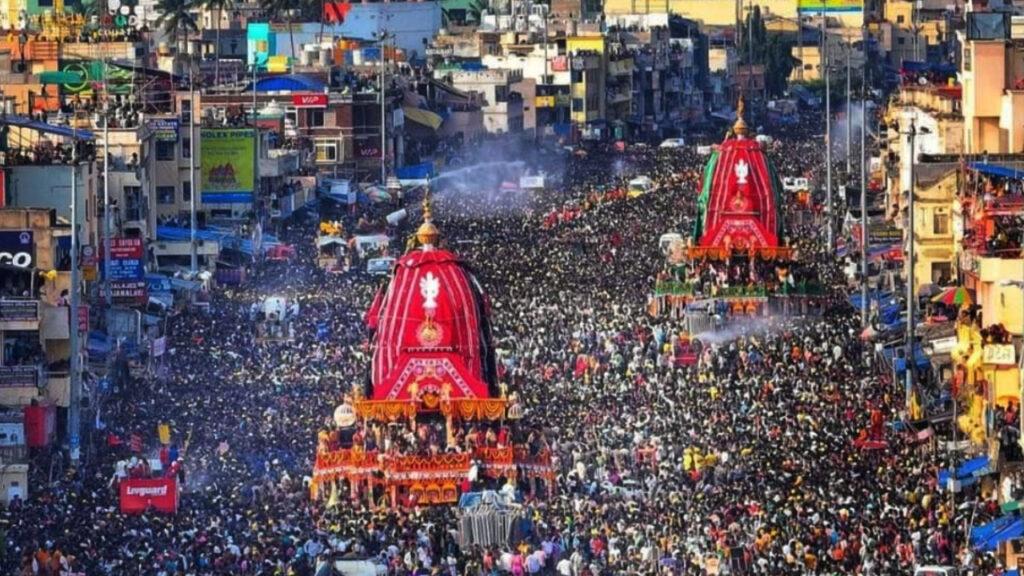Puri Rath Yatra, also known as the Jagannath Rath Yatra, is one of the grandest and most revered festivals in India. This annual event, celebrated in Puri, Odisha, is dedicated to Lord Jagannath, his elder brother Lord Balabhadra, and his sister Goddess Subhadra. Rath Yatra is a magnificent display of devotion, unity, and celebration, attracting millions of devotees from across the globe who come to witness the divine journey of the deities from their temple to the Gundicha Temple.
Puri Rath Yatra 2025 is a much-anticipated event, and here’s everything you need to know to plan your participation, from the significant dates to the rituals that define this auspicious occasion.
Date and Duration of Puri Rath Yatra 2025
Jagannath Rath Yatra 2025 will begin on June 27, 2025, and conclude on July 5, 2025. Festival spans over nine days, during which various important rituals take place, culminating in the return journey of the deities to the Jagannath Temple.
Key Rituals and Dates of Puri Rath Yatra 2025
Puri Rath Yatra involves a series of significant rituals that are deeply rooted in tradition. Here’s a breakdown of the key rituals and their respective dates:
- Snana Purnima (June 12, 2025)
- Ritual marks the formal beginning of the Rath Yatra preparations. On this day, the idols of Lord Jagannath, Lord Balabhadra, and Goddess Subhadra are brought out of the temple and given a ceremonial bath with 108 pots of sacred water from the Golden Well of the Jagannath Temple. This is followed by a public viewing of the deities.
- Ritual marks the formal beginning of the Rath Yatra preparations. On this day, the idols of Lord Jagannath, Lord Balabhadra, and Goddess Subhadra are brought out of the temple and given a ceremonial bath with 108 pots of sacred water from the Golden Well of the Jagannath Temple. This is followed by a public viewing of the deities.
- Anavasara (June 13 – 26, 2025)
- After the Snana Purnima, the deities are kept away from public view for 15 days in a ritual known as Anavasara. During this period, the idols are believed to recuperate from the bathing ritual. It is said that Lord Jagannath, Balabhadra, and Subhadra fall ill and are treated with traditional remedies. Marks the period when the Jagannath Temple is closed for darshan.
- After the Snana Purnima, the deities are kept away from public view for 15 days in a ritual known as Anavasara. During this period, the idols are believed to recuperate from the bathing ritual. It is said that Lord Jagannath, Balabhadra, and Subhadra fall ill and are treated with traditional remedies. Marks the period when the Jagannath Temple is closed for darshan.
- Gundicha Marjana (June 26, 2025)
- Day before the Rath Yatra begins, the Gundicha Temple, the destination of the Rath Yatra, is thoroughly cleaned. Ritual is known as Gundicha Marjana, symbolizing the preparation of the temple for the arrival of the deities. The cleaning is done with great devotion and care, as the deities are believed to visit their aunt’s home, the Gundicha Temple, during this journey.
- Day before the Rath Yatra begins, the Gundicha Temple, the destination of the Rath Yatra, is thoroughly cleaned. Ritual is known as Gundicha Marjana, symbolizing the preparation of the temple for the arrival of the deities. The cleaning is done with great devotion and care, as the deities are believed to visit their aunt’s home, the Gundicha Temple, during this journey.
- Rath Yatra (June 27, 2025)
- Main event, the Jagannath Rath Yatra, begins on this day. Deities are ceremoniously placed on their respective chariots, and the grand procession commences. Devotees from all over the world gather in Puri to witness the deities being pulled through the streets by thousands of devotees. Journey takes the deities from the Jagannath Temple to the Gundicha Temple, a distance of about 3 kilometers. Pulling the chariots is considered extremely auspicious, and devotees participate with the belief that it grants them the blessings of Lord Jagannath.
- Main event, the Jagannath Rath Yatra, begins on this day. Deities are ceremoniously placed on their respective chariots, and the grand procession commences. Devotees from all over the world gather in Puri to witness the deities being pulled through the streets by thousands of devotees. Journey takes the deities from the Jagannath Temple to the Gundicha Temple, a distance of about 3 kilometers. Pulling the chariots is considered extremely auspicious, and devotees participate with the belief that it grants them the blessings of Lord Jagannath.
- Hera Panchami (July 1, 2025)
- Hera Panchami is observed on the fifth day of the Rath Yatra. According to tradition, Goddess Lakshmi, the consort of Lord Jagannath, visits the Gundicha Temple in search of her Lord, who has left the Jagannath Temple for this journey. Ritual marks a symbolic expression of Goddess Lakshmi’s dissatisfaction at being left behind.
- Hera Panchami is observed on the fifth day of the Rath Yatra. According to tradition, Goddess Lakshmi, the consort of Lord Jagannath, visits the Gundicha Temple in search of her Lord, who has left the Jagannath Temple for this journey. Ritual marks a symbolic expression of Goddess Lakshmi’s dissatisfaction at being left behind.
- Bahuda Yatra (July 4, 2025)
- Bahuda Yatra marks the return journey of the deities from the Gundicha Temple back to the Jagannath Temple. The return procession is equally grand, and the deities once again grace the streets of Puri as they make their way back to their original abode. During this journey, a brief stop is made at the Mausi Maa Temple (Aunt’s Temple) to pay homage to the deity Ardhashini.
- Bahuda Yatra marks the return journey of the deities from the Gundicha Temple back to the Jagannath Temple. The return procession is equally grand, and the deities once again grace the streets of Puri as they make their way back to their original abode. During this journey, a brief stop is made at the Mausi Maa Temple (Aunt’s Temple) to pay homage to the deity Ardhashini.
- Suna Besha (July 5, 2025)
- Day following the Bahuda Yatra, the deities are adorned in gold ornaments, a ritual known as Suna Besha. Spectacular event showcases the deities dressed in elaborate gold jewelry, symbolizing their divine majesty and splendor. It is believed that this special darshan brings immense blessings to those who witness it.
- Day following the Bahuda Yatra, the deities are adorned in gold ornaments, a ritual known as Suna Besha. Spectacular event showcases the deities dressed in elaborate gold jewelry, symbolizing their divine majesty and splendor. It is believed that this special darshan brings immense blessings to those who witness it.
- Niladri Bijay (July 5, 2025)
- Final ritual of the Rath Yatra, Niladri Bijay, marks the return of the deities to the sanctum sanctorum of the Jagannath Temple. After spending nine days outside the temple, the deities are ceremoniously welcomed back to their divine abode. Special offering of Rasgulla is made to Lord Jagannath by Goddess Lakshmi, symbolizing the reconciliation between the divine couple.
Significance of Puri Rath Yatra
Puri Rath Yatra holds immense religious and spiritual significance for millions of devotees. Journey of Lord Jagannath, Balabhadra, and Subhadra from the Jagannath Temple to the Gundicha Temple is believed to symbolize several important spiritual truths:
- Rath Yatra represents the journey of the soul towards liberation, with Lord Jagannath leading the way as the charioteer of the universe.
- Festival symbolizes the universal brotherhood and unity of mankind, as devotees from different walks of life come together to participate in the pulling of the chariots.
- Rath Yatra is also considered a public darshan of the deities, as it is one of the rare occasions when Lord Jagannath, Balabhadra, and Subhadra leave their temple and appear before the devotees.
Rath Yatra is not only celebrated in Puri but has inspired similar festivals across the world, from the streets of London to New York and beyond.







